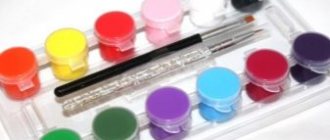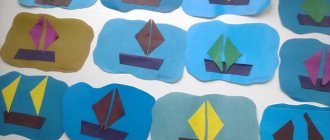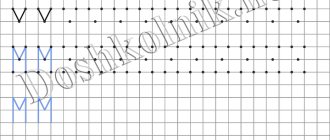Specific options for compositions on the topic “Water transport” in the senior group
Traditionally, in the second half of the school year (February), pupils of the senior group are offered an application on the theme “Steamboat”. A similar activity can be timed to coincide with February 23, and then a postcard with a picture of a steamship will become a gift for dad or grandfather.
In addition to the steamboat, you can offer preschoolers other variations on the theme of water transport. So the topic of the lesson can be designated as “Motor ship”, having previously explained to the children how these two types of transport differ (since the main role here is played not by external differences, but by the principle of operation of the engine).
Children can also use appliqué to create an image of a sailboat, submarine, or yacht (the teachers first explain in detail the characteristic features of each type of water transport).
In the older group, appliqué work on this topic can be done collectively, with each child performing some part of the composition. All elements are then combined against a common background. The topic of such a lesson can be designated as “Boats on the River”, “Seaport” or “Ships in the Roadstead”.
Making a boat using a template
This is one of the simplest options for making a panel applique, which a child can handle even in kindergarten. The essence of this craft is to cut out the details of the ship according to a pre-printed template, and then paste them onto the prepared background.
Needed for work
- Cardboard for background;
- Colored paper in the shades you want to see on the boat;
- Paper glue;
- Scissors.
To make this application yourself, just follow a simple diagram:
- We print out the details of the boat on a piece of paper (this can be done immediately on the back of sheets of colored paper) or transfer their outline from the computer screen onto the sheets and cut them out.
- Glue two waves onto the background.
- Now the main part of the boat and its mast.
- To give the picture a sense of volume, glue another wave on top of the base of the ship.
- We attach the sails and flag to the mast.
- The last step is to complement the composition with clouds and a flying bird.
You can also make three-dimensional versions of appliqués from simple geometric details. For example, creating a sail fluttering in the wind is very easy.
Class notes
| Author's full name | Title of the abstract |
| Yanova O. | "Steamboat" Educational objectives: learn to compose an image of a steamship from parts, consolidate the ability to cut off the corners of a rectangle, cut out other parts of a steamship of different shapes, practice cutting out identical parts from paper folded like an accordion, improve the ability to harmoniously arrange an image on a sheet. Developmental tasks: enrich preschoolers’ knowledge on the topic “Water transport”, develop imagination, fine motor skills, and attention. Educational tasks: cultivate accuracy, patience, perseverance. Integration of educational areas: “Artistic creativity”, “Cognition”, “Communication”, “Socialization”, “Health”. Demo material: pictures depicting a steamship, a ship's captain. Handout: sheets of blue paper according to the number of children, white and brown paper rectangles, small pictures with the image of the captain, glue, scissors, oilcloths, glue brushes, rags. Progress of the lesson: The lesson begins with a riddle about the postman. The teacher reports that the postman brought two envelopes to the group. The first contains a riddle about the captain:
There are also paper parts for appliqué: white and brown stripes, one long and wide, the other narrower and shorter. The captain wants to teach the children how to make a steamboat out of two rectangles. Physical school is carried out:
The teacher repeats the rules for handling scissors with the children. The teacher explains the sequence of making the steamer. First, you need to cut a trapezoid from a large rectangle by bending it in half and cutting off the corners. Then a pipe consisting of a square and a rectangle is cut out. Round portholes are cut out of a square folded in four. Independent activity of children. Analysis of works. |
| Gurina O.A. | "Ship" The teacher informs the preschoolers that the country will soon celebrate a holiday - Defender of the Fatherland Day. There is a conversation about dads who were once soldiers because they served in the Army. It is discussed what qualities a soldier should have. Physical school is carried out:
The teacher talks with the children about what they can give to dad and leads them to the conclusion that the best gift is the one made with their own hands. The teacher offers to make dads a postcard with a picture of a boat and reads a poem to the children:
Children share their impressions after listening to the poem. The finger game “Brave Captain” is being played:
The teacher explains the stages of making the craft. Moreover, the sun and waves are cut out with curly scissors. The ship has a sail, which is located at an acute angle upwards. The sailboat is accompanied by faithful friends - white gulls. Independent activity of preschoolers. At the end of the lesson, the children dance to the song “Blue Water.” |
| Kazunina Yu.P. | "Submarine at Sea" The lesson begins with a riddle about a submarine:
The teacher shows the children a presentation about this type of water transport. The children learn that all submarines are dark in color and have a distinctive shape. The teacher shows the children a sample of the applique that she made in advance. A sheet of paper is tinted with wax crayons, and the sky is multi-colored. This happens when the sun drops below the horizon. The submarine is glued in the middle of the sheet because it is the main element of the composition. The sun is a yellow circle, and the clouds are designed in a broken way from a white rectangle. Seagulls complement the seascape. Physical education is conducted to the music:
Independent work of children. Exhibition of finished compositions, discussion of the features of the works, highlighting the most spectacular and neat ones. |
| Ushmaeva M. | "The boat is sailing, sailing..." (application with drawing elements) The teacher reads the English song “The boat is sailing, sailing”:
The teacher informs the children that they have arrived on a fabulous uninhabited island and invites them to play the game “The Sea Is Worried Once.” Next, preschoolers are invited to a magnetic board, where reproductions and pictures of ships are presented. The children discuss what they saw. The teacher reads an excerpt from “The Tale of Tsar Saltan...” by A.S. Pushkin:
Children are invited to conduct an experiment - blow on a paper napkin and show how “the wind blows across the sea.” Then the teacher informs the children that they will make an applique of a sailboat today. The structure of a sailing ship is clarified, and methods for depicting volumetric sails are discussed. For preschoolers who can quickly complete the task, the teacher suggests creating relief waves using napkins. Physical education “Seagulls are circling above the waves” is being held:
Independent activity of preschoolers. Summing up the lesson. |
We create an applique with a boat from cereals
Another fascinating tutorial is creating appliqués from cereals. You can use buckwheat, rice, millet and even semolina.
A step-by-step description of the process of creating a panel with a boat from cereals:
- We prepare the necessary materials: cardboard for the base, PVA glue, various cereals, as well as a drawing of a ship.
- Then the boat is transferred to the base with a simple pencil, and work begins on filling its contours with cereal.
- To begin with, a contour is laid out. The base is smeared with glue, grains are glued to it.
- Then the inside.
- The remains of semolina and other cereals are shaken into a bowl or carefully blown away.
Using the same principle, you can make a warship out of sand:
Photo gallery of finished works - ideas for teachers
The application is combined with gouache painting and plasticineography
The applique is combined with drawing with wax crayons. A combination of applique (boats made using origami) and drawing (the sky and reeds)
Original waves are made from strips using the breaking technique
Simple origami, which is complemented by drawing
Application in the form of a postcard for dad with original waves (the teacher prepares them)
A broken applique with filling in a drawn template. Children fill in the drawn outline with pieces of paper; sails made from bright fragments look colorful
Applique classes should practice and improve the visual skills of preschoolers, as well as expand their horizons and knowledge about the shape of surrounding objects. Thus, the theme of a boat or a boat sailing along a river can be played out in a very interesting way, using the right motivation and using unusual materials.
How to make a ship out of shells with your own hands
Did you bring a lot of shells from the sea? They can be used and beautifully decorated by making a boat out of shells. Resorts sell ready-made souvenirs in the form of ships made of shells, but it is much nicer to put on a shelf a craft made by your child.
Materials:
- Big shell
- Small shells
- Super glue
- Braid
Come up with a diagram of your ship.
Place several shells in a row with a toothpick. It will look more beautiful if you arrange the shells according to size - wider at the bottom and smaller at the top.
Lubricate a toothpick with glue and attach the shells. Let's leave it to dry.
Let's attach these sails to a large shell. The base of the toothpick should be generously coated with glue.
We use a chain or gold braid. We wrap it around the mast. To ensure that the boat stands level, you can glue a large shell onto a piece of wood or a flat stone.
Individualization of tasks
In fine arts classes, it is imperative to use an individual approach. So, for children who are not yet very good at handling scissors, you can offer to make only boats (hulls), and for those who are already good at cutting out parts - boats with a sail.
During the applique class, the teacher should actively encourage the manifestation of children's activity and creativity. Some children cope with any work quickly, so they definitely need to complicate the task even more - offer to supplement the composition with details: for example, cut out the sun and clouds from paper or decorate their boat with details. You can also give paints so that the child can depict rain or fish looking out of the water.
There are many options here. The main thing is to captivate the child so that his interest in creativity only becomes stronger.
Some children quickly and efficiently cope with basic work; they definitely need to be given additional tasks in order to maintain interest in creativity




